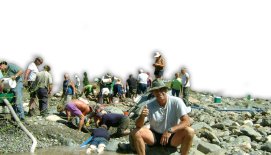By Dave McCracken
Unfettered development of natural resources are the foundation of a free, prosperous society!

 When we get out of bed in the morning, we step onto the carpet (calcium carbonate/limestone is used in the carpet backing). Many of us go directly to the kitchen to switch on the electric light and coffee pot. They are made either of aluminum, iron, copper, glass or ceramic (glass and ceramic are made entirely from minerals–silica sand, limestone, talc, lithium, borates, soda ash, and feldspar). While moving around the kitchen, we will be standing on linoleum (calcium carbonate, clay, and wollastonite) or ceramic tile. Once we get our cup of coffee, we may sit down to read the newspaper. Running across the travel section, we recall that we are planning a trip today, so we take a moment to consult the Official Airline Guide and then refer to the Yellow Pages of the telephone book to find the local number for the airline. All of these papers are filled with kaolin clay and use lime-stone, sodium sulfate, lime and soda ash in their processing. Then we fix a piece of toast and sneak a piece of cake from last night’s party (bakery items, such as bread, contain gypsum as an ingredient, and cakes have a high content of gypsum in the icing). The plate we are eating off of is made of glass, ceramic or china, the last being a special form of ceramic.
When we get out of bed in the morning, we step onto the carpet (calcium carbonate/limestone is used in the carpet backing). Many of us go directly to the kitchen to switch on the electric light and coffee pot. They are made either of aluminum, iron, copper, glass or ceramic (glass and ceramic are made entirely from minerals–silica sand, limestone, talc, lithium, borates, soda ash, and feldspar). While moving around the kitchen, we will be standing on linoleum (calcium carbonate, clay, and wollastonite) or ceramic tile. Once we get our cup of coffee, we may sit down to read the newspaper. Running across the travel section, we recall that we are planning a trip today, so we take a moment to consult the Official Airline Guide and then refer to the Yellow Pages of the telephone book to find the local number for the airline. All of these papers are filled with kaolin clay and use lime-stone, sodium sulfate, lime and soda ash in their processing. Then we fix a piece of toast and sneak a piece of cake from last night’s party (bakery items, such as bread, contain gypsum as an ingredient, and cakes have a high content of gypsum in the icing). The plate we are eating off of is made of glass, ceramic or china, the last being a special form of ceramic.
All of the food that we eat relies completely upon industrial minerals for its growth and production. All fertilizers are composed of some combination of potash, phosphates, nitrogen, sulfur and other minerals. Soils with a large degree of acidity must be regulated with gypsum, limestone or sulfur. In fact, without industrial minerals, there could not be any modem-day agriculture as we know it.
As we get ready for our trip, we brush our teeth with toothpaste (calcium carbonate/limestone/sodium carbonate). Ladies put on lipstick (calcium, carbonate and talc) and powder (talcum), and men might prepare their hair with hair cream (calcium carbonate). Other forms of makeup would have various minerals as a constituent. The lavatory countertop in the bathroom where we stand is a nice synthetic marble or synthetic onyx (titanium dioxide, calcium carbonate and alumina hydrate).
The sinks, lavatories, toilets and similar fixtures throughout the house are kept shiny with cleansers (silica, pumice, diatomite, feldspars, and limestone). Kitchen and bathroom tiles are installed, kept in place, and maintain their waterproof condition with putty and caulking compounds (limestone and gypsum).
Our automobile is entirely composed of metals and industrial minerals. Tires contain clays and calcium carbonate. Mag wheels are made from dolomite and magnesium. All of the glass in the car is made entirely from minerals, as is the fiberglass body now becoming popular on many models.
Many of the components in a car are now being made of composites, generally combinations of fiberglass and plastics. Plastics require calcium carbonate, wollastonite, mica, talc, clays and silica for their manufacture. The paint which makes our car so attractive is largely composed of industrial minerals–titanium dioxide, kaolin, clays, calcium carbonate, micas, talc, silica, wollastonite, and others.
In fact, every speck of all paints that we encounter today, from that on our house to the strip down the middle of the road, to the interior of our homes and offices, and everywhere else, is mainly composed of industrial minerals.
Gasoline and lubricants come out of the ground, but also depend upon industrial minerals; because the drill bit which originally reached the crude oil was made from iron and faced with industrial diamonds. Drilling fluids, used for well drilling, are composed almost entirely of barite, bentonite, attapulgite, mica, perlite, and others. It is necessary to employ clays and zeolites in the catalytic cracking process for crude petroleum to arrive as gasoline and lubricants.
Concrete pavement is composed of cement and aggregates–sand and gravel or crushed stone, such as limestone, dolomite, granite, lava, and so on. Cement is manufactured from limestone, gypsum, iron oxide, clays and possibly pozzolan. Even blacktop has industrial minerals as aggregates.
The buildings we work in are made from concrete, stone, brick or wood (wood is mined from the earth by Mother Nature). Many buildings have steel structural members. Besides the steel being made from iron ore, the steel production process requires fluorspar for fluxing, bentonite for pelletizing, and possibly chromite for hardening. Steel production requires the use of high-grade refractory bricks and shapes made from bauxite, chromite, zircon, silica, graphite, kyanite, andalusite, sillimanite and clays.
The interior of our buildings and homes are enclosed by wallboard or sheetrock (gypsum with fire-retardant additives, such as clays, perlite, vermiculite alumina hydrate and borates) joined together with joint cement (gypsum, mica, clays and calcium carbonates).
Plate-glass windows are made entirely from industrial minerals.
Our office supplies also come out of the ground. Pencils (graphite and clays), invoices with self-contained carbon paper (bentonite, other clays, or zeolites), pens, paper, calculators, computers, office equipment all come from metals and industrial minerals. Even some inks contain calcium carbonate or other fillers.
During our leisure time, our recreational devices, including golf clubs, tennis rackets, fishing rods and skis are commonly made from graphite or fiberglass. Our back-pack frames and pots and pans are often made from aluminum (all aluminum for whatever usage originates with bauxite, one of the most widely used industrial minerals).
Our communications and electronics equipment employ numerous industrial minerals. The standard product of the electronic industry for years has been the silicon chip, made from quartz or silica. Optical fibers, made from glass, are replacing some copper wiring. Television screens and computer monitors are made of glass, but critical tubes also contain phosphors made from rare earths or lanthanides, a family of industrial minerals. Even the super conducting materials that are presently getting so much attention use industrial minerals (yttrium, lanthanides, titanium, zirconium, and barite) in their manufacture.
Filtering and purification are major duties of the industrial minerals. Preparation of our drinking water uses minerals for purification and clarification (limestone, lime and salt), as do the wastewater-treatment plants (zeolites, soda ash, lime, and salt).
Many of our medical supplies and pharmaceuticals come directly from minerals, or could not be manufactured or processed without the use of metals and minerals from the ground.
Everything comes out of the ground, one way or another. Everything! Whether Mother Nature or people do the mining through agriculture, or mankind does it through mineral extraction. Mining is the basic building block of our entire society as we know it today. In fact, the reason why the United States of America is the leading economic and industrial nation in the world is because we have figured out how to utilize raw material from the earth better and faster than other nations.
Our entire social, economic and industrial base fully depends upon our ability to pull metals and minerals from the earth and utilize them.
So when you read articles in newspapers and magazines, or see special documentaries on television about how bad mining is for the country, you know you are hearing from individuals who really do not understand what it takes to keep things going. None of those people want to go back to living in caves! Or more likely, they are people who are pushing forward a political agenda (many without even knowing it) to re-establish government control over all productive activity (socialism or worse).
Even all of the materials and equipment used to prevent pollution, or to clean up existing pollution, will need to be mined out of the ground and/or processed from metals and minerals taken from the earth.
“Look at the terrible hole mining left in the ground! “
This is what the environmentalists say about us. They do not say anything about the wonderful buildings, homes, highways, modem appliances, medical wonders, communications and electronics which were created from that hole in the ground; things which they take for granted every moment of their lives.
All of the environmentalist/conservationist individuals and groups running around trying to shut down agriculture, timber harvesting, mining and other productive activities, are utilizing the products from these very same activities in everything they do during every hour of every day. In fact, the very success of the environmental movement fully depends upon our modem infrastructure, all which is a result of metals and minerals being taken out of the earth. They could not get by unless we continue our good work!
Here is a very interesting video which shows the truth about how modern mining helps develop more advanced economies and provides more freedom and opportunity to everyone:
So the debate is not really about whether mining and productive activity will continue. The debate is about who will control it. This battle has been waging since the beginning of recorded history. It has not ended since we have arrived in the modern age. But we have reached the modern age largely because America led the way in granting individuals the personal freedom to pursue mineral extraction in private enterprise, along with all of the innovation which evolves from it. America established the right of an individual to own and possess the fruits of his or her hard work (the right to own your possessions).
All of the noise about the evils of mining and development (in the name of environmentalism, saving the planet, global warming, etc) are really a ploy to re-establish total government control over all means of productive activity, and to erode your right to the ownership of what you have earned.
That’s it!
Editorial note: Much of the information contained here was taken from United States Geological Survey Bulletin #1958





